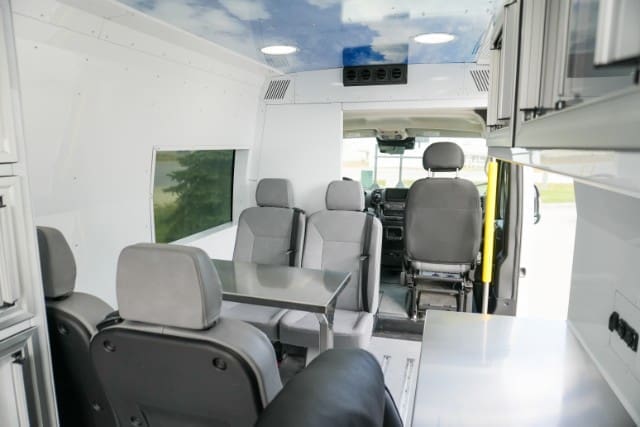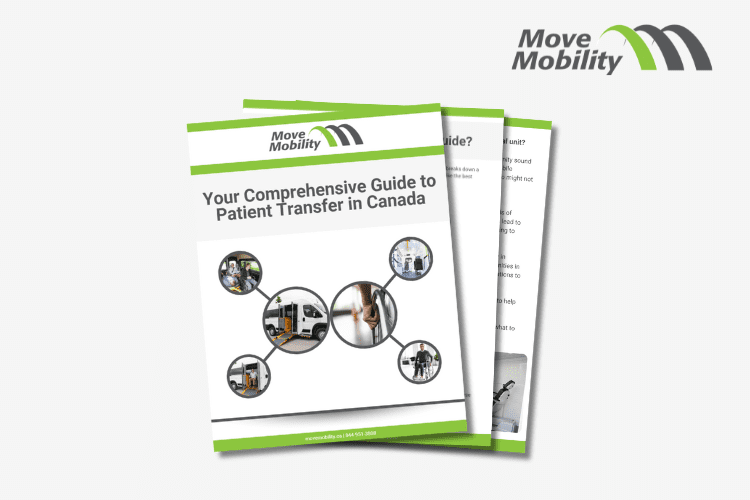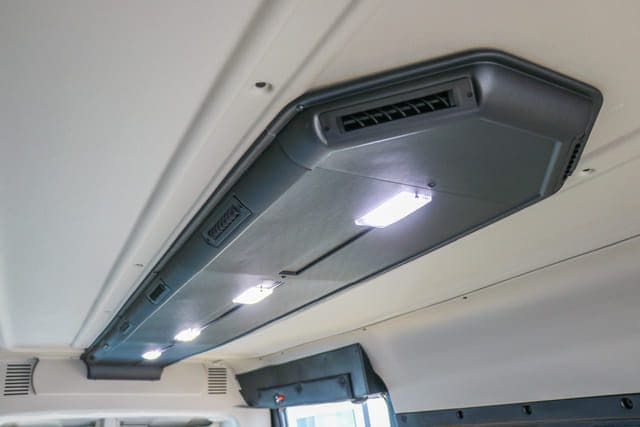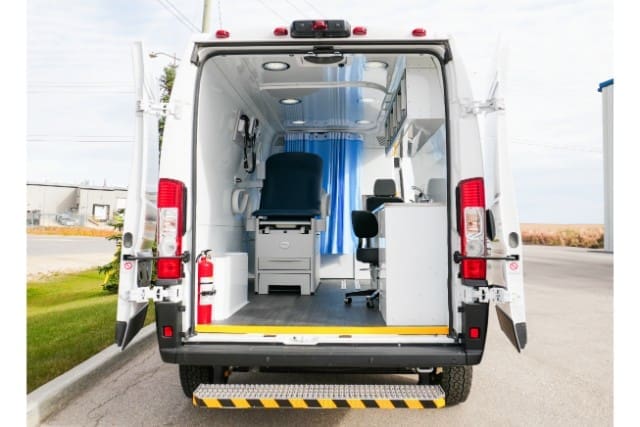Did you know: Homelessness in Vancouver affected over 2,420 people in 2023 alone? The number is growing every year, and each person represents a story, a struggle, and a gap that hasn’t been filled. If you’re part of an organization trying to tackle this crisis, it probably feels overwhelming. How can you make a real difference?
The issue is clear: Too many people in Vancouver don’t have access to the help they need. Without action, the homeless population in Vancouver will keep growing. That means more people living on the streets and fewer resources to go around. But it doesn’t have to be this way.
What if we told you there was a way you could help people find support, warmth, and care when they are often at their lowest points in life? Your organization can be a big part of this change.
At MoveMobility, we’ve been helping organizations like yours and the Quest Community Health Centre for over 20 years. We design vehicles that remove barriers to healthcare and transportation because we believe mobility is a game-changer. Our work helps communities like Vancouver offer better solutions to those who need them. While we know we’re not the only option out there, we’ve built our reputation on creating vehicles that save lives and make a real difference.
In this article, you’ll learn how your organization can help prevent homelessness in Vancouver. We’ll talk about the problem, explore solutions like Mobile Outreach Vans, and help you see how you can use them to create real change.
Why is homelessness such a big problem in Vancouver?
Homelessness in Vancouver is a serious issue affecting thousands of people.
Several key factors contribute to this problem:
1. High housing costs: Vancouver has some of the most expensive housing in Canada. Many people can’t afford to buy or rent homes, leading to a growing homeless population in Vancouver.
2. Lack of affordable housing: There aren’t enough low-cost housing options. This shortage forces many into homelessness, as they have nowhere else to go.
3. Low income: Some people don’t earn enough to cover basic living expenses. Even with jobs, they struggle to afford housing, increasing the homeless population in Vancouver.
4. Mental health and addiction issues: Challenges like mental illness and substance use disorders can lead to homelessness. Without proper support, individuals may end up on the streets.
5. Limited support services: There aren’t enough resources to help those in need. This gap leaves many without the assistance required to find and maintain housing.
These factors create a complex situation, making it hard for many to find stable housing. Addressing these issues is crucial to reducing homelessness in Vancouver.
What barriers prevent organizations from helping the homeless population in Vancouver?
Helping the homeless population in Vancouver isn’t always easy. Organizations trying to make a difference often face roadblocks that can feel overwhelming.
Let’s break down some of the challenges:
Hard-to-reach people: Many homeless individuals live in difficult-to-access areas. They might not be near shelters or other services, so finding and helping them becomes tricky.
Limited access to healthcare and support: A lot of people experiencing homelessness can’t get to clinics or other resources. Without transportation or easy access, they miss out on the care they need.
Getting resources where they’re needed: Transporting staff, supplies, or even meals to different locations can take a lot of time and effort, slowing down the speed at which help can be provided.
High costs for permanent locations: Setting up and running a fixed facility like a shelter or clinic costs a lot of money. Not every organization can afford it, even if they know it’s needed.
Too many people needing help: Vancouver’s homeless population is large, and the demand for help can overwhelm the existing services. It’s tough to keep up when there are so many people in need.
These challenges can make it hard for organizations to make a lasting impact. But recognizing these barriers is the first step toward finding real solutions.
Can the Mobile Outreach Van help prevent homelessness in Vancouver?
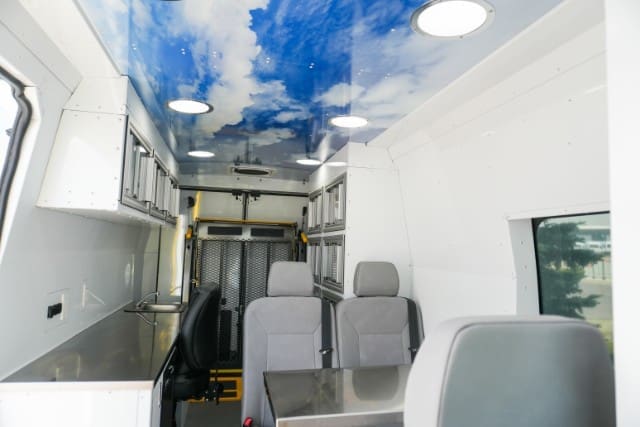
A Mobile Outreach Van can make a big difference in helping the homeless population in Vancouver. Organizations like yours can use it to bring services straight to the people who need them, cutting out many of the barriers that make it hard to get help.
Here’s how it works:
Goes directly to the people: Not everyone can make it to a shelter or clinic. A Mobile Outreach Van shows up where people are—whether that’s on the streets, in parks, or in remote areas.
Builds trust in the community: Seeing the same van and friendly faces over time helps people feel safe. They know someone is there to help and won’t judge them.
Offers privacy and dignity: Asking for help isn’t easy, especially for people dealing with addiction or mental health challenges. A Mobile Outreach Van creates a private, welcoming space where people feel less judged.
Helps with basic health needs: Mobile Outreach Vans can provide first aid, check-ups, or even vaccines. They help people stay healthier and catch problems early.
Provides important resources: From food and clothes to hygiene kits and referrals to shelters or job programs, the van brings essentials that make daily life easier and help people find their next steps.
Gives a sense of hope: Talking to someone who cares can make a big difference. Mobile Outreach Vans don’t just offer supplies—they offer encouragement and direction. It’s a step toward a brighter future for Vancouver’s homeless population.
What features of the Mobile Outreach Van help with homelessness in Vancouver?
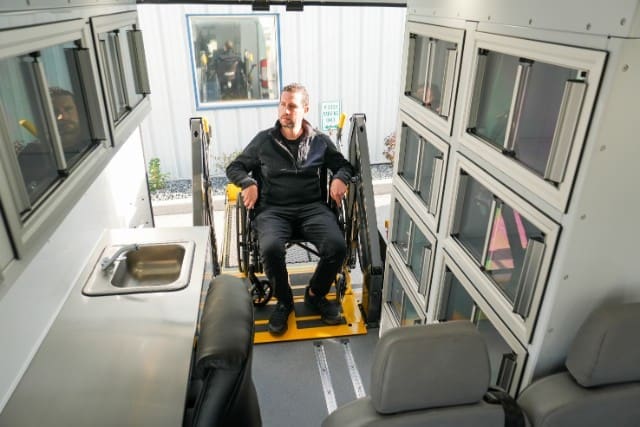
The Mobile Outreach Van is packed with features designed to meet the needs of Vancouver’s homeless population. Each feature addresses specific challenges, making it easier to provide help and build trust.
Here’s how these features make a real difference:
| Feature | How it helps homeless people in Vancouver |
| Floor-to-ceiling aluminum medical storage cabinets | Stores medical supplies for treating minor injuries or illnesses directly on the street, where care is most needed. |
| Sliding cabinet doors | Makes it easier to access supplies in tight urban areas without creating clutter or hazards. |
| Mobile office desk space with secured rolling chair | Gives staff a space to fill out forms, connect people with resources, or provide counselling in a professional and organized way. |
| Options for sink and fridge | Helps with hygiene needs, like cleaning wounds or storing food and medication for people who lack basic necessities. |
| Overhead storage | Keeps extra supplies like blankets, toiletries, and non-perishable snacks available for distribution on the go. |
| Equipment and records storage | Safeguards sensitive medical records or tools, making it easier to track care for repeat visits and build a care plan. |
| Cab divider | Provides privacy during conversations, making individuals feel more comfortable opening up about their needs. |
| Removable passenger seats | Frees up space to transport additional supplies, offer shelter to individuals in extreme weather, or provide a ride to a shelter or hospital. |
| Power supply | Powers equipment, like mobile phones for emergency calls or medical devices used for on-the-spot treatment. |
| Rear heat and air conditioning | Ensures a safe, temperature-controlled environment, giving people relief from Vancouver’s cold winters or hot summers. |
| Clean, comfortable environment | Creates a space where people feel welcome and respected, breaking down barriers to seeking help. |
These features make the Mobile Outreach Van so much more than just a vehicle. It becomes a safe haven for people who often feel invisible, offering warmth, care, and a sense of dignity. Each detail, from the medical storage to the comfortable environment, is designed with their needs in mind. For those living on Vancouver’s streets, it’s about knowing someone cares enough to meet them where they are and offer hope for a better tomorrow.
Want to learn more about the Mobile Outreach Van?

You came here because you’re looking for ways to make a real difference for the homeless population in Vancouver. You might have been wondering how to overcome challenges like reaching people in need or finding better ways to provide care. These are tough questions, but they show how much you care about creating change.
After reading this article, you’ve learned a few key things:
- Barriers exist that make helping the Vancouver homeless population difficult, but they aren’t impossible to overcome.
- A Mobile Outreach Van can be a powerful solution for reaching people where they are, providing support, and even connecting them to homeless shelters in Vancouver.
- Tools like this offer hope for a better future for those experiencing homelessness in Vancouver.
At MoveMobility, we design wheelchair accessible and mobile medical vehicles to break down barriers to healthcare and transportation. Every van we build is made with your mission in mind, so you can focus on what matters most—helping people.
We know your work isn’t easy, but it’s important. Together, we can help make life better for Vancouver’s homeless population and bring real change to the city. If you have any questions or want to talk about how a Mobile Outreach Van could work for your organization, click the button below to chat with a mobility expert.
Not ready to connect yet? No problem! We have more resources you can check out to learn how to help prevent homelessness in Vancouver.
Start by checking out our article on how to choose the best van for your outreach program.
If your organization focuses on counselling the homeless population in Vancouver, you might be interested in our article on the Mobile Counselling Van.


